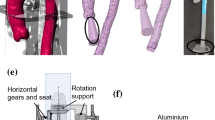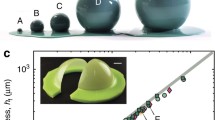Abstract
A multi-step dip-spin coating procedure by which synthetic vessels of virtually the entire cardiovascular system can be constructed from medical imaging data was developed to consistently and accurately fabricate silicone membranes with prescribed compliance for in vitro hemodynamic experimentation and medical device development. Experimental results showed that the three factors tested (silicone mixture viscosity, mold diameter, and number of dips in solution) each had a statistically significant effect on the resulting wall thickness of the fabricated silicone membranes. A setup was designed and constructed to test the compliance of the silicone membranes, and a prediction model showed that the most important factors for compliance were the mean pressure used to pressurize the membranes, the membrane wall thickness, and the difference in membrane diameter between the two test pressures. The manufacturing process was repeatable with a process standard deviation of 0.002753 cm for an average wall thickness of 0.063576 cm (4.33%).
Similar content being viewed by others
References
Herger JW et al (1998) Cardiology. William & Wilkins, Baltimore, MD
Ahumada GG (1987) Cardiovascular pathophysiology. Oxford University Press, New York, NY
Topol EJ (1998) Textbook of cardiovascular medicine. Lippincot Ravet, New York
Willerson JT, Cohn JN (2000) Cardiovascular medicine. Churchill Livingstone, Philadelphia
Rhee K, Tarbell JM (1994) A study of the wall shear rate distribution near the end-to-end anastomosis of a rigid graft and compliant artery. J Biomech 27(3):329–338
Hopkins LM et al (2000) Particle image velocimetry measurements in complex geometries. Exp Fluids 29:91–95
Tai NR, Salacinski HJ, Edwards A, Hamilton G, Seifalian AM (2000) Compliance properties of conduits used in vascular reconstruction. Br J Surg 87:1516–1524
DuPont Dow Elastomers (2001) Neoprene latex dipped good technical information. Wilmington, DE
Kostlin H, Frank G, Hebbinghaus G, Anding H, Denissen K (1997) Optical filters on linear halogen-lamps prepared by dip-coating. J Non-Cryst Solids 218:347–353
Cortez MA (2002) Fabrication of silicone models of cardiovascular systems with prescribed compliance. Master of Science Thesis, University of Texas at El Paso, El Paso, TX
Chung TS (1999) Fabrication of multi-layer composite hollow fiber membranes for gas separation. J Membr Sci 152:211–225
Montgomery DC (1997) Design and analysis of experiments. Wiley, New York
Stevanov M, Baruthio J, Eclancher B (2000) Fabrication of elastomer arterial models with specified compliance. J Appl Physiol 88:1291–1294
White R, Klein S, Shors E (1987) Preservation of compliance in a small diameter microporous, silicone rubber vascular prosthesis. J Cardiovasc Surg 28:485–490
Abbott W, Megerman J, Hasson J, L’Italien G, Warnock D (1987) Effect of compliance mismatch on vascular graft patency. J Vasc Surg 5:376–382
Uchida N, Kambic H, Emoto H, Chen JF, Hsu SH, Marabayshi S, Harasaki H, Nose Y (1993) Compliance effect on small diameter polyurethane graft patency. J Biomed Materi Res 27:1269–1279
Gryna FM (2001) Quality planning and analysis: from product development through use, McGraw Hill Irwin, New York
Wicker RB, Medina F (2003) Framework for physical modeling of complex internal flow passages using rapid prototyping and water-soluble molds. Proceedings of the 31st International Conference on Computers and Industrial Engineering, San Francisco, CA, February 2–4, 2003, pp 559–564
Wicker RB, Cortez M, Medina F, Palafox G , Elkins CJ (2001) Manufacturing complex compliant cardiovascular system models for in vitro hemodynamic experimentation using CT and MRI data and rapid prototyping technologies. Proceedings of the 2001 Summer Bioengineering Conference, ASME Bioengineering Division (BED) 50:469–470
Acknowledgements
The research presented here was performed at UTEP in the W.M. Keck Border Biomedical Manufacturing and Engineering Laboratory (W.M. Keck BBMEL) using equipment purchased through Grant #11804 from the W.M. Keck Foundation. Support for UTEP was also provided through a research contract (#28643) from Sandia National Laboratories (SNL) in the Laboratory Directed Research and Development (LDRD) program, and the technical guidance of Alan Parker, Manager of Mechanical Engineering at SNL, is appreciated. Sandia National Laboratories is a multi-program laboratory operated by Sandia Corporation, a Lockheed Martin Company, for the United States Department of Energy’s National Nuclear Security Administration under contract DE-AC04-94AL85000. The financial support and guidance of Edward Egbert, M.D., on this project was invaluable. The authors are grateful to Dr. Charles Taylor at Stanford University for providing the geometric computer model of the stenosed pig aorta used to demonstrate the compliant vessel manufacturing process. The opinions expressed in this paper are those of the authors and do not necessarily reflect those of any other individuals or sponsors of the W.M. Keck BBMEL or its research.
Author information
Authors and Affiliations
Corresponding author
Rights and permissions
About this article
Cite this article
Cortez, M.A., Quintana, R. & Wicker, R.B. Multi-step dip-spin coating manufacturing system for silicone cardiovascular membrane fabrication with prescribed compliance. Int J Adv Manuf Technol 34, 667–679 (2007). https://doi.org/10.1007/s00170-006-0649-5
Received:
Accepted:
Published:
Issue Date:
DOI: https://doi.org/10.1007/s00170-006-0649-5




